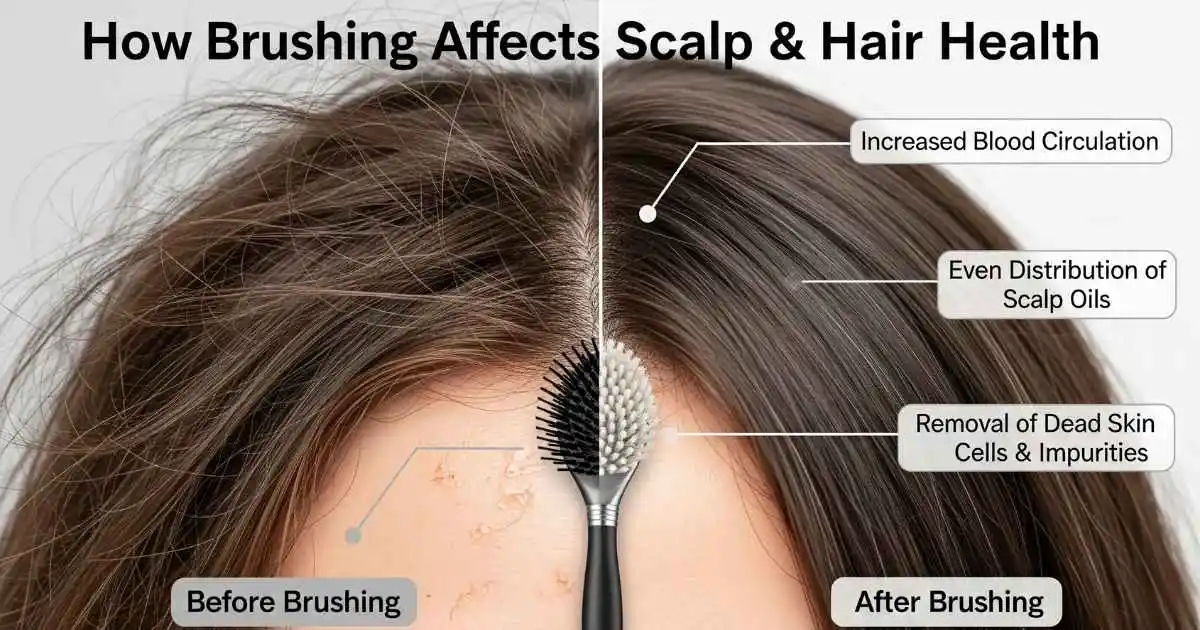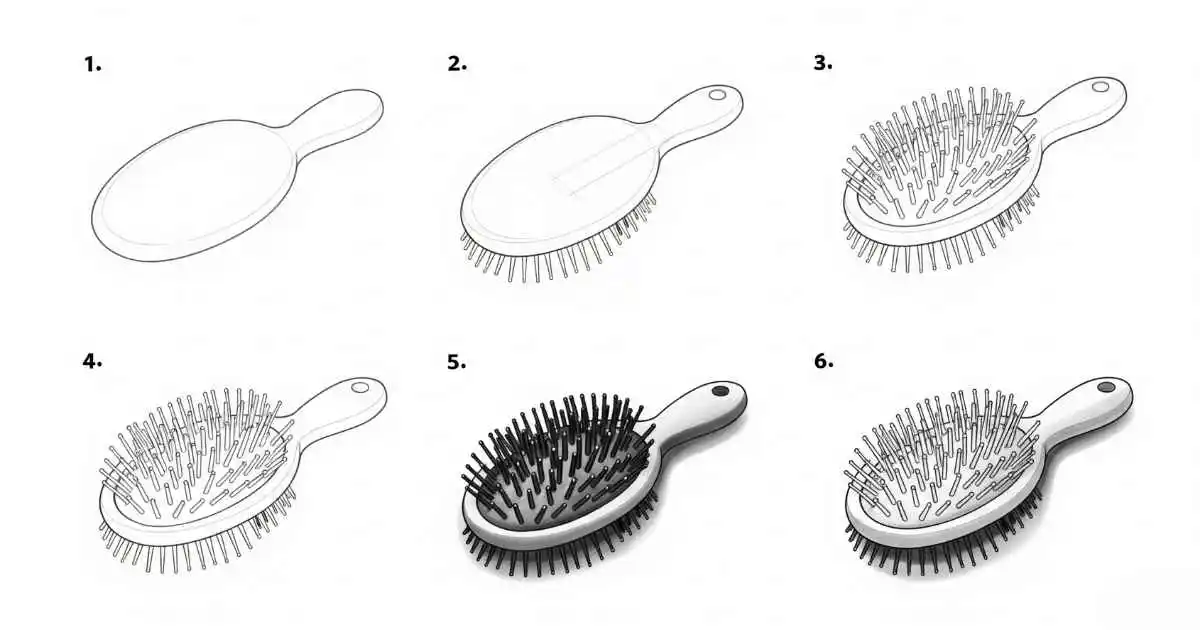Most of us brush our hair every day without giving it much thought. For many, it’s just part of the routine to keep hair neat and tangle-free. Can brushing of hair helps for hair growth?
You’ve probably heard people say that brushing can help your hair grow faster and healthier. While this may sound like just another beauty myth, there’s actually some science behind it. Brushing impacts not only the strands but also the scalp, where hair growth begins.
In this guide, we’ll explore whether brushing really supports hair growth, the right way to do it, and which tools can make a difference. By the end, you’ll know how to brush your hair to keep it stronger, healthier, and less prone to breakage.

Quick Navigation & Previews
- Brushing of Hair for Hair Growth
- How Brushing Affects Scalp & Hair Health
- How Often Should You Brush Your Hair?
- Should You Brush Wet or Dry Hair?
- Why Cleaning Your Hair Brush is Essential
- Fun Activity: How to Draw a Hair Brush (For Beginners & Kids)
- Extra Tips to Boost Hair Growth (Beyond Brushing)
- Conclusion
- Frequently Asked Questions (FAQs)
Brushing of Hair for Hair Growth
Brushing is not just about grooming—it’s about scalp health and overall hair maintenance. Done correctly, it can play a supportive role in healthy hair growth.
- Scalp Stimulation – Brushing gently massages the scalp, increasing blood circulation. This delivers oxygen and nutrients to the hair follicles, which are essential for healthy growth.
- Oil Distribution – Natural oils (sebum) from your scalp are spread along the hair shaft when you brush. This nourishes your strands and helps prevent dryness.
- Shine & Smoothness – Brushing regularly keeps hair softer, shinier, and more manageable.

How Brushing Affects Scalp & Hair Health
When you brush properly, you’re not only styling your hair—you’re also caring for your scalp. Here are some benefits worth noting:
- Boosts Circulation – Gentle brushing works like a mini massage, increasing blood flow to the scalp and feeding the follicles.
- Exfoliates Dead Skin – Regular brushing helps clear away dead skin cells, which can reduce dandruff and buildup.
- Reduces Oil & Product Residue – A clean scalp is key for hair growth. Brushing breaks up excess oil and product that might clog pores.
- Prevents Breakage – Tangles can cause pulling and snapping. Brushing keeps hair smooth and less prone to breakage.
How Often Should You Brush Your Hair?
The best brushing routine depends on your hair type and condition. Here’s a quick guide:
- Oily Hair – Brush once or twice a day to spread oils evenly and avoid buildup.
- Dry or Curly Hair – Limit brushing to 2–3 times per week to protect natural oils and prevent frizz.
- Fine or Thinning Hair – Brush once daily, gently, to avoid stressing delicate strands.

Choosing the Right Hair Brush
Not all brushes are created equal. The right one can protect your hair, while the wrong one may cause damage.
| Brush Type | Best For |
|---|---|
| Paddle Brush | Straight, long hair |
| Round Brush | Styling & adding volume |
| Boar Bristle Brush | Distributing oils & adding shine |
| Detangling Brush | Wet or curly hair |
| Vented Brush | Blow-drying & reducing heat damage |
Should You Brush Wet or Dry Hair?
Brushing wet or dry hair makes a big difference in how your strands respond.
- Wet Hair – Hair is weakest when wet and can snap easily. If you need to detangle, use a wide-tooth comb or a detangling brush. Always start from the ends and work upward.
- Dry Hair – Safer for brushing as it’s stronger and less fragile. Detangle slowly, moving from tips to roots to avoid unnecessary pulling.
Why Cleaning Your Hair Brush is Essential
A dirty brush can undo all your good hair care efforts. Oils, dirt, and leftover products can transfer back to your scalp, causing clogged pores and greasy hair.
How to Clean Your Brush:
- Remove Hair – Pull out trapped hair after every use.
- Wash with Warm Water & Shampoo – Soak your brush to loosen dirt and buildup.
- Rinse & Air Dry – Let it dry fully before your next use.

Fun Activity: How to Draw a Hair Brush (For Beginners & Kids)
If you enjoy simple drawings, here’s a quick guide for kids and beginners:
- Draw an oval (the brush head).
- Add a handle extending downward.
- Sketch short lines for bristles inside the oval.
This easy drawing can be a fun way to teach children about hair care while boosting their creativity.
Extra Tips to Boost Hair Growth (Beyond Brushing)
Brushing is just one part of a healthy routine. To truly support growth, try these additional tips:
- Eat a Hair-Healthy Diet – Include protein, biotin, and omega-3 fatty acids.
- Switch to a Silk Pillowcase – Reduces friction while sleeping and prevents breakage.
- Limit Heat Styling – Minimize flat irons, blow dryers, and curling tools.
- Stay Gentle – Avoid aggressive or frequent brushing. Consistency matters more than force.
Conclusion
Brushing your hair is more than a styling habit—it’s a simple yet powerful step for maintaining scalp health and supporting stronger, shinier strands. While brushing alone won’t trigger new hair growth, it improves circulation, spreads natural oils, and prevents unnecessary damage. The key is choosing the right brush, brushing gently, and pairing it with a healthy routine.
If you want healthier, fuller-looking hair, think of brushing as part of a bigger picture: balanced nutrition, good scalp care, and smart daily habits. With the right approach, brushing can become your hair’s best friend.
Frequently Asked Questions (FAQs)
1. Does brushing your hair really make it grow faster?
Brushing doesn’t create new hair, but it stimulates blood flow to the scalp and spreads natural oils. This supports healthy follicles, which can indirectly help with growth.
2. How many times a day should I brush my hair?
It depends on your hair type. Once or twice a day is enough for most people. Curly or dry hair should be brushed less often—about 2–3 times per week—to avoid frizz and breakage.
3. What is the best type of brush for hair growth?
A boar bristle brush is often recommended because it distributes natural oils and is gentle on the scalp. For detangling wet or curly hair, a wide-tooth comb or detangling brush works best.
4. Should I brush my hair when it’s wet or dry?
Dry hair is stronger and safer to brush. If you need to brush wet hair, always use a wide-tooth comb or a detangling brush, and start from the ends to reduce breakage.
5. Can over-brushing damage hair?
Yes. Brushing too often or too aggressively can weaken strands, cause split ends, and irritate the scalp. Gentle, consistent brushing is far better than frequent, harsh strokes.
Leave a Reply